Fall Color Report
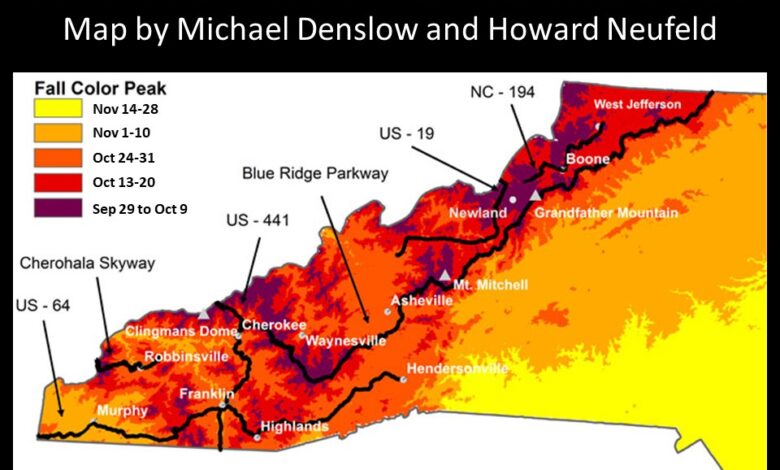
2025 Updates
For the 14th year in a row, WataugaOnline.com is teaming up with Dr. Howard Neufeld, Professor of Plant Eco-physiology at Appalachian State University, better known as The Fall Color Guy to provide information as the colors start changing. For reports from previous years click here.
Dr. Neufeld shared some thoughts just before previous fall seasons that are still relevant for this or any fall season:
As for wet weather, there have been some publications on the impacts of weather on fall color (especially timing, not so much quality). Precipitation has only minor effects on timing in the fall. Temperature is more important. So, at this point, I don't see anything to make me think that fall colors will be adversely affected, either in timing or quality.
What happens in mid- to late August and in September, temperature-wise, will be more important, especially for quality (notably the intensity of the red colors)”.
People think fall colors are good when they last a long time, and have plenty of brilliant reds interspersed with the oranges and yellows. So, the quality will depend on how much “redness” we have this fall.
Trees tend to make more red colors (anthocyanins) in the fall when it's cool and sunny, and if we have a slight but not severe drought.
Sunny days means more photosynthesis, and more sugars produced in the leaves, and sugars induce anthocyanin production.
A slight drought impairs uptake of nitrogen (we think) and some experiments suggest that plants low on N make more anthocyanins.
Usually, fall colors peak around Oct 11-14 in the Boone area; sooner by a few days up to a week at higher elevations, later at lower ones. Nice colors can stick around for a week or more, although the peak usually comes and goes in just a few days, weather permitting (no high winds for example)”.
Fall Color Report for October 15, 2025
Peak fall color for the High Country (Blowing Rock down to Linville Falls along the Blue Ridge Parkway (BRP) is happening right now. I’d say the peak started around Sunday and will last into this weekend, although good color will still be around into next week. Some trees are starting to lose their leaves now and so the best color after this weekend will be from the overlooks, although it will still be quite good right on the BRP.
I took the drive to Beacon Heights and Linn Cove Viaduct this morning; the colors are quite good right now. Now it’s not a banner year for color – I’d rate the colors a 6 or 7 on a scale of 10. But even these ratings are worth a trip up because a color rating of 6-7 means the leaves are quite beautiful. Remember, even in a bad year you will have a good time in the High Country!
What is causing me to downgrade the colors this year and not rank them an 8 or 9 is because of two factors: one is the extended drought, which is much more severe and long lasting than I anticipated, and the other is the warm temperatures we’ve been experiencing these last two weeks, particularly during the day. Nighttime temperatures are getting into the 40s which is good, but daytime temperatures are about 10-15 degrees warmer than I’d like for optimal color.
The drought is causing some trees to lose leaves prematurely, most notably the tulip poplars and birches, but even red and sugar maples are dropping their leaves too. The warm temperatures are diminishing the intensity of the red anthocyanins, so those trees aren’t jumping out at you as in years past. Nonetheless, there is good color out there and if you drive on the BRP you’ll go in and out of good color areas.
The weather this year has cooperated with tourists as there is little chance of rain, so you can expect to have the opportunity to do some hiking and other outdoor activities. A cold front coming in later in the week could bring some light rain on Sunday, but otherwise, the forecast is for clear, blue skies and moderate temperatures.
This weekend I will head up to Doughton Park which is on the border of Ashe and Alleghany counties and is the largest parcel of land managed by the BRP. I highly recommend a visit, and as I noted in a previous report, the BRP is now open continuously from the VA border all the way down to Linville Falls. After about a 30 mile break, it is open again from Craggy Gardens all the way to its terminus in Great Smoky Mountains National Park. So, you have essentially the entire BRP for fall foliage viewing.
Have a great weekend!
Fall Color Report for October 9, 2025
If you are thinking about coming up to the High Country to see the fall leaf colors, do it NOW. Since last Sunday, the trees have rapidly developed good color and the Blowing Rock to Grandfather Mountain section of the Parkway is nearing its peak, which I think will be the middle of next week. That means this weekend (Oct 10-12) and the next weekend (Oct 17-19) will bracket the peak color period.
I took the drive from Blowing Rock to Flat Rock (which is a few miles south of Grandfather) and the colors are very nice. Visitors I met on the Rough Ridge Trail, some of whom came from as far away as Jacksonville, FL, rated the colors around 6-8 on a scale of 10. My estimate was a 7 for this year, which while not the best, is still pretty darn good. My earlier fears of a dull leaf season are turning out to be unwarranted. Granted, it's not like 2022 when the colors were spectacular (10 out of 10), but they are definitely worth the trip up.
The timing is right on schedule. I checked my photos from as far back as 2010 on this same date and the stage of color development is essentially identical to this year's. So, the predictions of an early peak were wrong but at least we won't be late as occurred in 2019, when it was delayed by two full weeks.
Below the Parkway the trees are mostly still green but with color clearly starting. At the Parkway and above it is about 70-80% color and will increase to peak over the next 10 days. The weather is supposed to cooperate also, with no chance of rain over this time period. Temperatures will be cool with highs in the mid-60s and lows in the upper 30s and low 40s. Those are perfect conditions for generating good leaf color and for viewing the leaves.
I suspect similar conditions can be found down around the Highlands and Cashiers area, and along the Parkway between Great Smoky Mountains National Park and Mt. Mitchell. Also, there should be good viewing in the Doughton Park area up in Ashe County.
It looks like we’re in for a good fall leaf season after all!
October 2:
Starting in mid- August we experienced a lack of rainfall and temporarily went into a moderate drought situation. In mid-September we had considerable rain, and the drought situation was mostly eliminated.
However, when a tree gets stressed by drought, it begins a series of responses to reduce water use, trying to avoid the loss of leaves and fine roots to desiccation.
Once started, this process is essentially irreversible. The first reaction by trees is to close the stomata on their leaves. A stoma consists of two adjacent cells connected at their ends that can flex open or close, thus regulating the exchange of CO2 and H2O.
Closing the stomata greatly lowers water loss, but also photosynthesis, since CO2 can't get into the leaf. Trees do this when drought stressed and at night (mostly), since no photosynthesis can happen in the dark.
If the drought continues, hormonal changes occur, including the accumulation of ABA, which causes stomatal closure, and the upregulation of ethylene synthesis (a hormone in gaseous form).
Ethylene causes leaves to senesce (die), and once this starts, the process is irreversible, even if it rains and the drought is alleviated.
I am seeing a lot of leaves falling prematurely from the tulip poplars, a tree known to be sensitive to drought, from birches, which likewise are sensitive, and even from red maples.
As a result, I think there may be fewer leaves out there this year in some places. The attached photo is of a mountain peak near Boone, NC, and you can see lots of bare trees. Also, a sourwood with its red leaves and white seeds.
Luckily, most of the other species are holding onto their leaves, and the hills between 3,000-4,000′ are still lush green.
So, while we're still on track for good color, in those places with sensitive species, it may not be as vibrant.

Grandfather Mountain Daily Fall Color Report | Sept. 28, 2025:
Even under gray skies, Grandfather Mountain continues to show signs of transitioning tones.
Color is beginning to spread throughout the highest elevations of the mountain.
Photo by Skip Sickler | Grandfather Mountain Stewardship Foundation
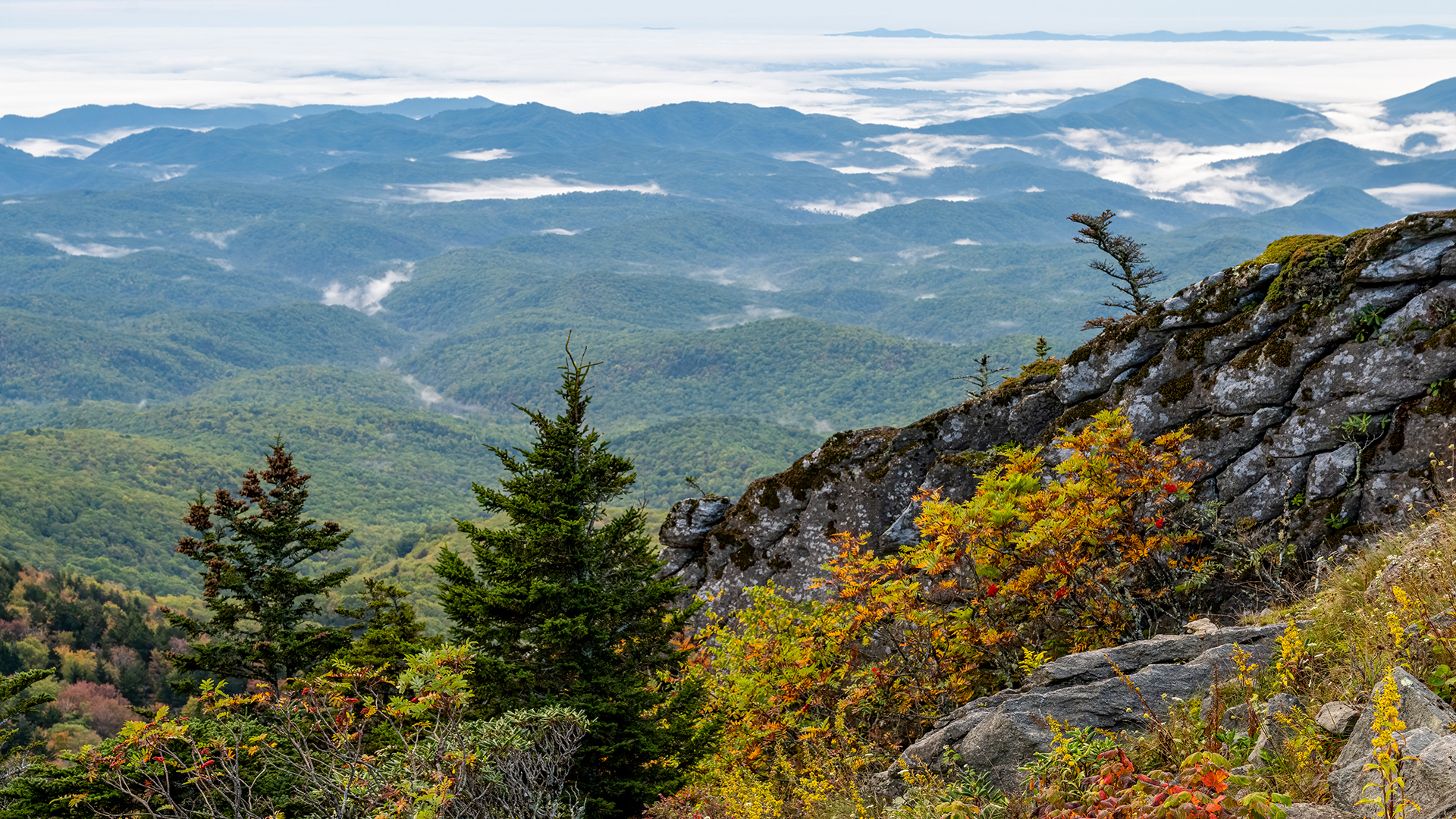
Grandfather Mountain Daily Fall Color Report | Sept. 27, 2025:
We are reflective of Hurricane Helene’s path through Western North Carolina one year ago today. This year’s fall color brings with it a sense of hope and renewal.
The High Country has shown resilience and a strong sense of community, who is ready to welcome you back. Today’s photo was taken earlier this week on the mountain’s switchbacks.
Photo by Leslie Restivo | Grandfather Mountain Stewardship Foundation
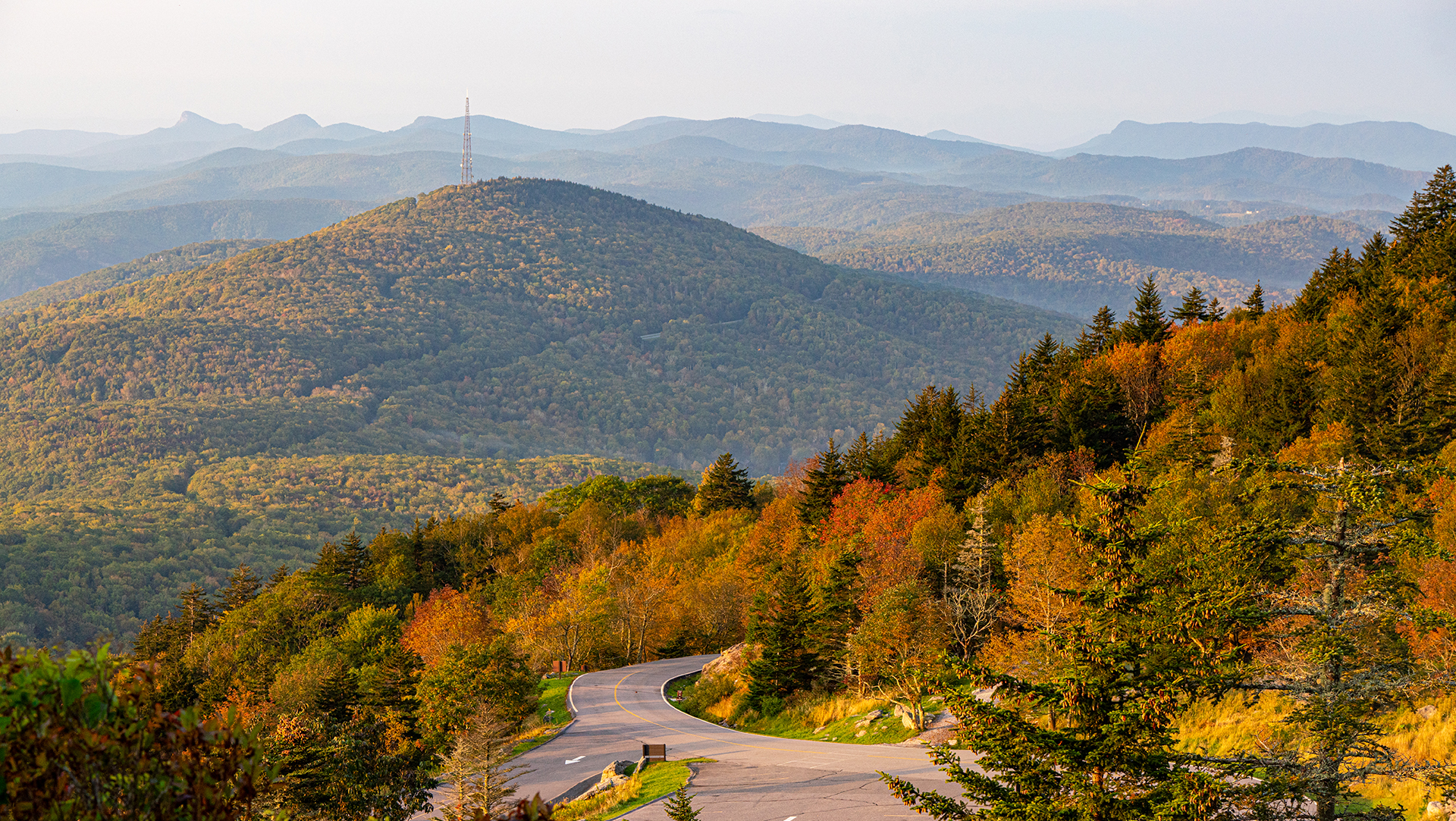
Grandfather Mountain Daily Fall Color Report | Sept. 26, 2025:
Those hoping to catch fall color often look up, taking in the brilliant hues from towering trees.
Plenty of color can be found by looking down, however, as numerous bushes, shrubs and plants break out their autumn best!
Photo by Skip Sickler | Grandfather Mountain Stewardship Foundation
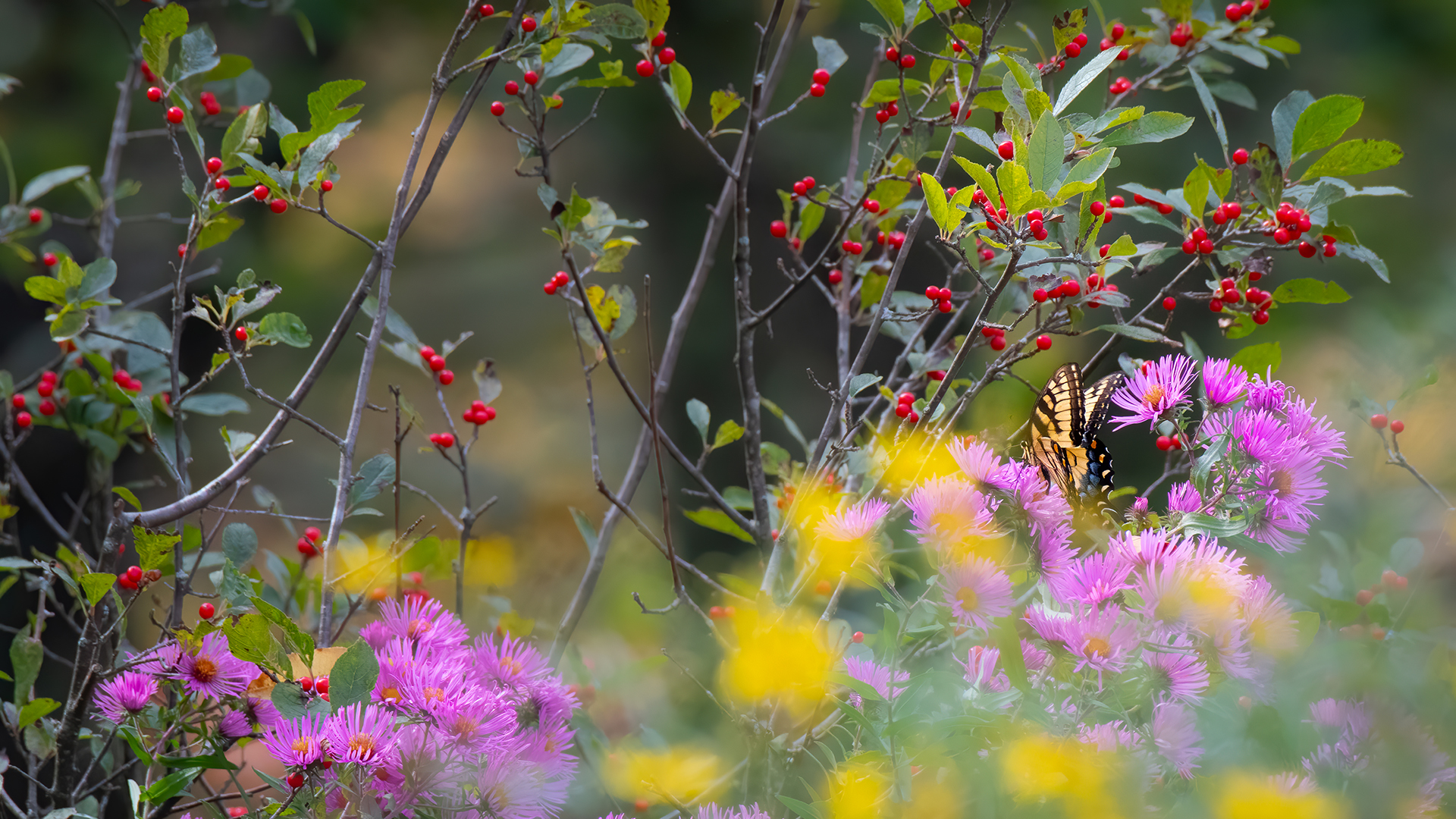
Grandfather Mountain Daily Fall Color Report | Sept. 25, 2025:
While most of the landscape on Grandfather Mountain and in surrounding areas is still green, some spots of color are appearing.
An exciting way to welcome the hues of fall is to take note of the mountain ash berries that are a vibrant red and present from the peaks of the mountain to the entrance gate this time of year.
Photo by Leslie Restivo | Grandfather Mountain Stewardship Foundation

Grandfather Mountain Daily Fall Color Report | Sept. 24, 2025:
In September, a succession of warm, sunny days and cool, crisp nights bring about the most spectacular color displays.
During these days, lots of sugars are produced in the leaf, but the cool nights and the gradual closing of veins going into the leaf prevent the sugars from moving out. These conditions – lots of sugar and light – spur production of the brilliant reds and crimsons that we see.
Photo by Skip Sickler | Grandfather Mountain Stewardship Foundation

Grandfather Mountain Daily Fall Color Report | Sept. 23, 2025:
Standing at Scheer Bluff on Grandfather Mountain and looking out towards the Blue Ridge Parkway is one of the first areas to see the leaves changing color each year.
When awaiting the leaf change, Grandfather Mountain Stewardship Foundation staff know to keep an eye on this area for pops of red and orange to welcome the start of fall. The overall landscape of the region is still mostly green; however, color is beginning to creep in.
Photo by Grayson Ross | Grandfather Mountain Stewardship Foundation
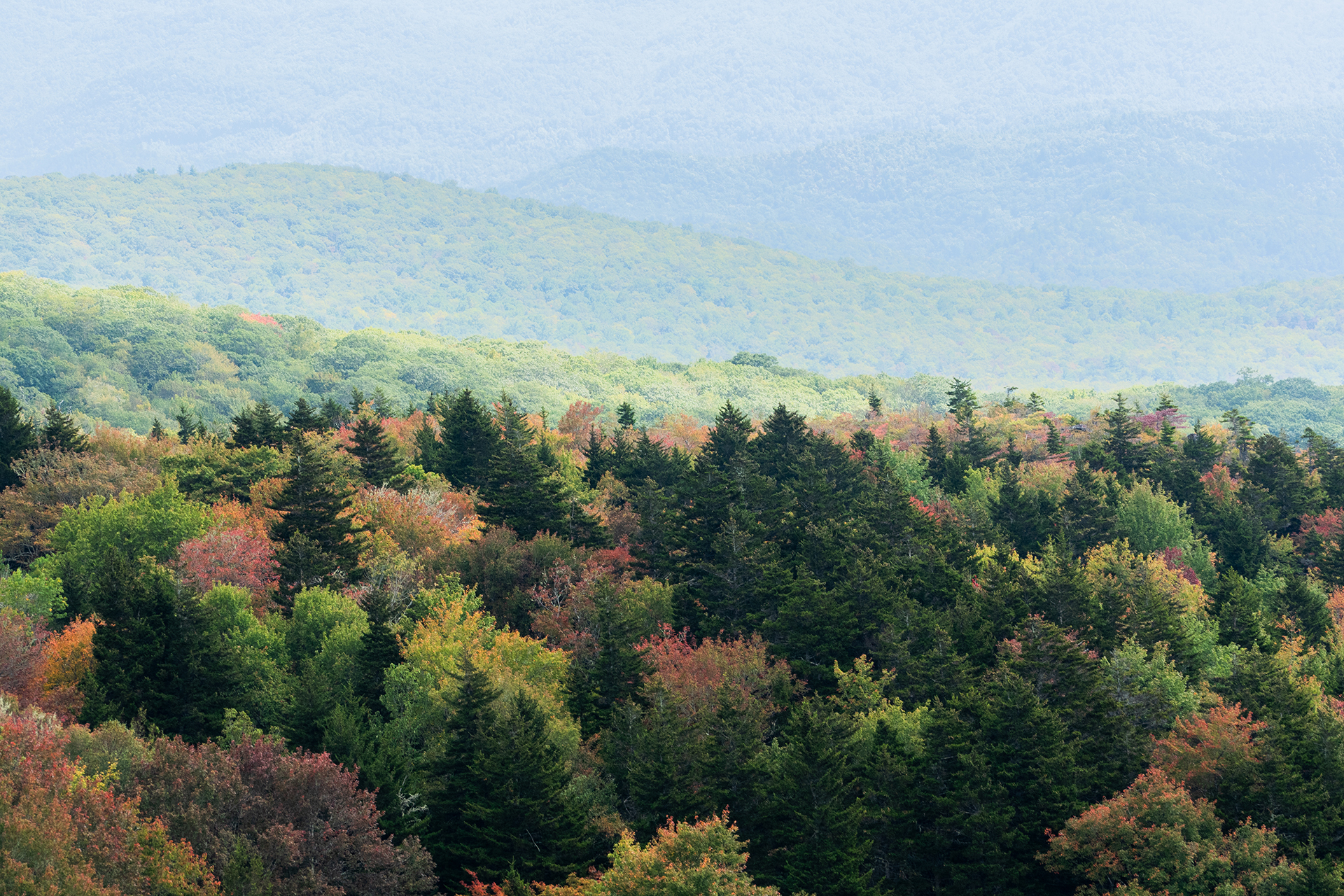
Grandfather Mountain Daily Fall Color Report | Sept. 22, 2025:
Hints of fall color are appearing in the N.C. High Country, especially at higher elevations, as seen here in this photo of the Mile High Swinging Bridge taken from Linville Peak. The area has experienced many sunny days and cool nights the last few weeks, prompting the seasonal transition.
While some pockets of color and certain trees are very vibrant at the moment, the overall landscape is still mostly green. At the top of the mountain, you can see blueberry bushes transitioning to hues of red and pops of color among the evergreens.
Photo by Leslie Restivo | Grandfather Mountain Stewardship Foundation
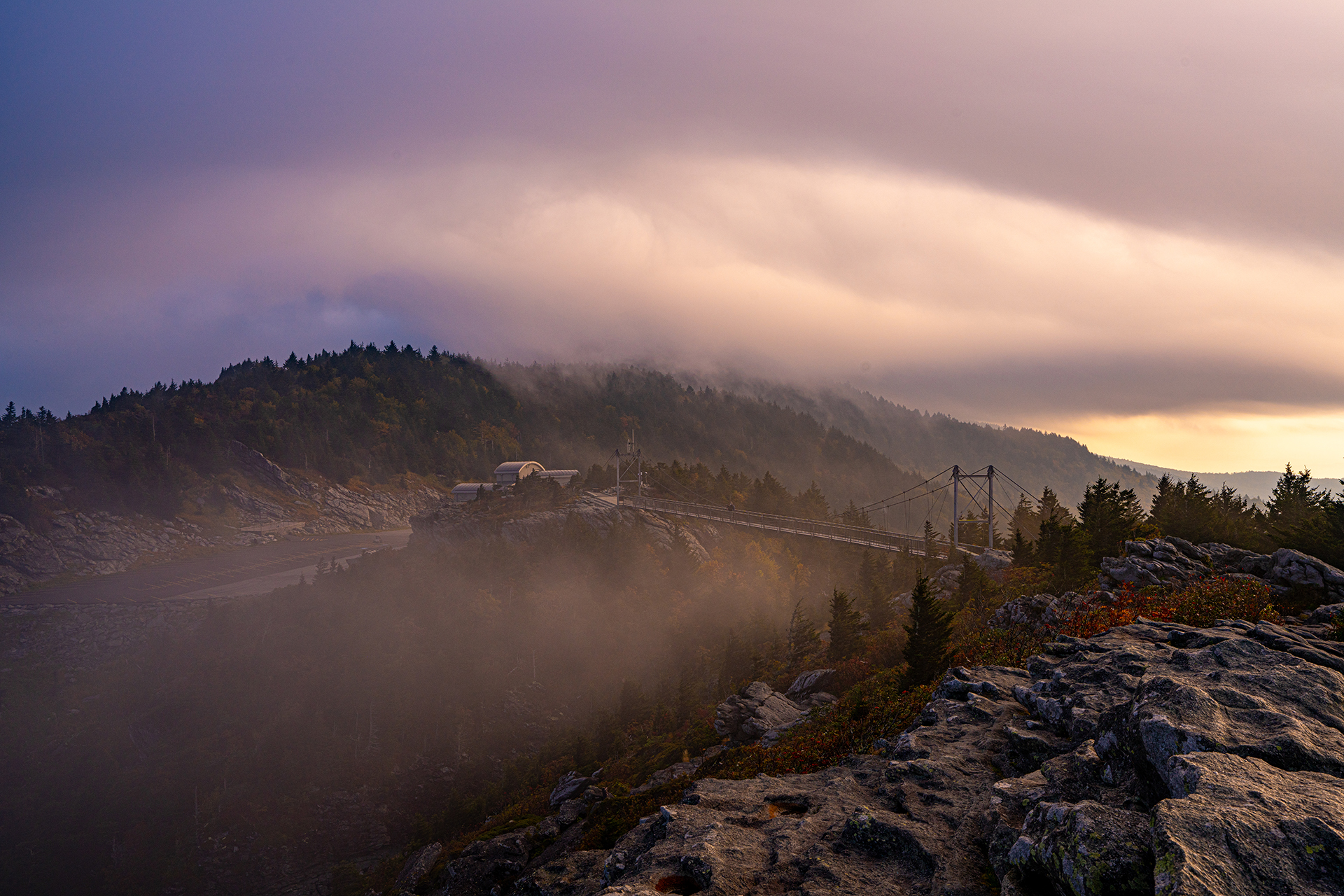
Foliage Report for September 18, 2025
I took my first fall foliage drive of the season this morning, to both check out how the colors are doing and to see how long I could be out and about, given I had my surgery just over a month ago. I’m happy to report that both tasks were successively accomplished – I was in the car about an hour and a half, traveled about 46 miles, and, was able to see the current state of the leaves. This is about how far I must travel to do lab work, so it wasn’t too much of an exertion. I did no hiking though – not up to that yet. Just drove and stopped at overlooks.
So, here’s my report. Leaves are definitely turning color early this year, no doubt a result of the cool down that occurred in August and the lack of excessively high temperatures in September (excluding the expected high temperatures this Sat and Sun though). There is observable color at 3,000’ and especially above 4,000’. For this time of year, I think the amount of color is more than I’ve seen in previous years.
Much of the color is due to sugar maples, tulip poplars, birches, cherries, sumacs, and sourwoods. Although colors are turning early, the forests are still 90-95% green. If you’re thinking of coming up this weekend or next, I’d suggest you try high elevation sites to get the most color, such as Graveyard Fields below Asheville, Craggy Gardens about 20 miles north of Asheville, and Elk Knob State Park about 8 miles north of Boone.
In town, the urban trees are peaking brilliantly right now. Lots of bright red maples, yellow/orange sugar maples, and deep burgundy red flowering dogwoods. Tulip poplars are yellowing up nicely along with a lot of birches.
For my trip today, I drove down to Linville, then got on the Blue Ridge Parkway (BRP) and headed north. A few miles down the road there is a nice pull off on the left with good views of Grandfather Mt. Those pics are shown in this posting. If you continue heading north, you will get to the Beacon Heights parking area, also with good views of Grandfather. The short trail there takes you up to the top of a large rock outcrop with eastern and southern views of the Wilson Creek drainage area, plus the Linville Gorge Wilderness Area, and Table Rock. If you go left near the top where the trail forks, you get to another rock outcrop, this time with views of Grandfather, Blowing Rock to the north, and areas east. The trail is only about a half a mile, so it’s easy and short.
Getting back on the BRP going north you quickly encounter the Linn Cove Viaduct section, perhaps the most well-traveled portion of the BRP. You can pull into the visitor center parking area just before the viaduct (the center itself is closed) and there is a trail at the end that you can take to beneath the viaduct that has some nice views. If you continue beyond the viaduct for several miles, you will get to Rough Ridge, which is probably the most popular hiking trail on the BRP.
I highly recommend the Rough Ridge trail, but get there early in the day or go midweek, as on the weekends it gets very crowded, and parking is at a premium. The trail goes up to a boardwalk after about a quarter of a mile (after crossing a beautiful wooden bridge that overlies a mountain creek). There are great views from that point and if you don’t want to exert yourself any further, there is no need to go to the top. But for those that do, you can see some spectacular views from the rock outcrop at the summit.
After Rough Ridge, the next four overlooks are closed because the NPS is repaving the parking lots. However, I spoke with someone from the NPS and those repairs are going quickly, so I think that by the end of September, they may reopen.
If you continue heading north, you’ll soon get to Price Lake. There is camping there, but check the website for availability, because some sites are not open. All the trails are open however, and I saw early color at the lake, which surprised me. There is a 2 mile trail, nearly flat, no climbing, that goes around the lake, which I recommend. You can also rent a boat and to out on the lake.
My last stop was at the Thunderhill Overlook, about 1 mile north of where the BRP crosses US 321. There wasn’t much color there yet and the views are of forests at much lower elevations, which were very much still green.
So, to conclude, colors are definitely appearing in the High Country, and others have told me the same is happening farther south at Graveyard Fields and Craggy Gardens. So, the next two weekends should be great for fall color viewing, even if they are ahead of peak color. Weather reports show no signs of rain until Tuesday next week and high temperatures up here should be in the upper 60s to maybe 71F at most. Perfect for leaf peeping!
Foliage Report for September 16, 2025
I need to post this update to my previous report, because since that posting, since there have been some new developments, plus a lot of color has started showing up in the High Country (at least in some places). If any information is wrong here, it is partly due to the fact that no one now answers the phones at the visitors center, possibly due to budget cutbacks that have severely curtailed services at most National Parks this year, and so I can’t get up-to-date information for you.
Most importantly, Mt. Mitchell State Park (milepost 355 on the Blue Ridge Parkway (BRP) reopened to visitors as of yesterday (https://www.ncparks.gov/state…/mount-mitchell-state-park). But you must get on the Parkway just north of Asheville to get there. You cannot get on NC Rt. 80 and head south on BRP because it is closed in that stretch.
This means that the Craggy Gardens Visitor Center (https://www.blueridgeparkway.org/poi/craggy-gardens/), which is located 20 miles north of the BRP Visitor Center near Asheville, at milepost 364.4 is now open also. However, the picnic area just north of there is still closed. If you want to get on the Pinnacle Trail (which I highly recommend for its spectacular views and wildflower displays), I am told you can get to it from the visitor center parking lot, but I can’t confirm that. It would mean a longer hike to the top if you can even do it all. However, the views from the Visitor Center are quite good.
Just north of Mt. Mitchell to near Little Switzerland is the last unopened section of the BRP and it doesn’t look like it will be open for this fall’s leaf color season. But as I noted in the previous posting, there is a three mile segment that allows you to get to The Orchard at Altapass (https://altapassorchard.org/) at milepost 328.3.
Our spate of cool weather did indeed jump start some of the trees. However, with the lack of rain over the past several weeks, we’re starting to see the effects of water stress on some trees. The ones most affected are sycamores (Platanus occidentalis and P. orientalis), tulip poplars (Liriodendron tulipifera), and birches (Betula sp.). These species turn yellow, or may drop crinkled brown leaves early on as a result of the lack of water. They are particularly noticeable in the foothills, where the higher temperatures exacerbate the drought effects.
However, in my nearly 20 years of following fall colors, I have never seen peak color more than just a few days earlier than the long-term average time. In the attached graphic, you can see that only a few times in the past has peak color come especially early (at least in the 3,000’-4,000’ elevational range). More commonly, warm temperatures substantially delay peak color, as you can see happened in 2018 and 2019, when those Octobers had way above normal temperatures.
In town, a variety of trees are peaking now, mainly the Freeman maples (which are bred for their fall leaf color and commonly planted throughout the region), little leaf linden trees (Tilia cordata: I saw some in the Harris Teeter parking lot in Boone, of all places; they turn yellow), and burning bushes (Euonymus alata) are flaming red now (pun intended).
I see the beginnings of color on the hills surrounding Boone, while others have noted this at the higher elevations in the High Country. If you want to go to Craggy Gardens I’d suggest doing so this coming weekend and the next to catch it near peak. Same for Graveyard Fields (milepost 418.8 down near Canton: https://www.nps.gov/places/graveyard-fields.htm), which peaks early given its 5,120’ elevation. I also think that valley peaks earlier than expected because it gets cold air drainage from the surrounding hills. It’s called Graveyard Fields either because a windstorm took down lots of trees in the past, or logging left it barren of trees, or both, with the stumps looking like gravestones. There is a nice waterfall with a wooden boardwalk, plus a 3.2 mile loop trail. There can be bears, so be aware and parking is very limited, so get there early.
I also include a table of the most common fall color tree, shrubs and vines and the colors they turn in the fall. Might be use to some of you when you're out viewing this season. Enjoy!
Fall Color Report for September 11, 2025
This year we are all hoping for a great fall leaf color season. So far, the weather is cooperating, with lower than normal temperatures here in the High Country (this morning’s low was 45ºF) and mostly sunny skies. If this trend continues for the next 3-4 weeks, then we should have great color on time. That means Oct 12-20 between 3,000-4,000’ elevation, a week earlier if higher, and a week later if lower. I’ll post some graphics soon to illustrate this.
Right now we are seeing just the beginnings of fall leaf color in the mountains, while urban street trees are coloring up quite nicely now. I had to go to North Wilkesboro today to do some lab tests and even there some trees in the parking lot were in full display. I noticed along the way that the sourwoods were coming along nicely, tulip poplars were showing some yellow, as were the birches.
But in the High Country, my greenometer is pegged hard on green. Yes, a few trees here and there have some color, but nothing major is happening right now. It’s going to warm up over the next few days a bit, so I don’t expect much color development this week. We are seeing a lot of goldenrods blooming now, and the Joe-Pye weed is in full display also.
Last year Hurricane Helene put a quick end to our fall leaf display. Not only were thousands of trees blown down, but roads were damaged and made impassable, while flooding and landslides decimated homes and businesses. Helene caused the death of 108 North Carolinians, making it the deadliest natural disaster in the state’s history. The economic impact was enormous also, estimated at $59.6 billion.
The fall color season, from September to November is the busiest tourist season in the western NC mountains. I once made a back of the envelope estimate of the amount of tourist dollars added to the economy of western North Carolina from September to November and my guess was $600-800 Million. But Wit Tuttell, Executive Director of Visit North Carolina, has stated that tourism may bring in $1.8 Billion to the western mountain economy, way higher than my estimate. Hurricane Helene was thought to take away $380 Million last fall alone.
Many businesses are still trying to come back, but some have rebuilt, and many are open and want to welcome visitors to the region. Your visit to the mountains of western North Carolina will go a long way toward contributing to the recovery of this area.
This year, much of the Blue Ridge Parkway (BRP) is open to visitors. The attached figure shows the closures from US 421 N toward Virginia, where both regular road construction activities and repairs from Hurricane Helene are going on. You can still get to Doughton Park and the restaurant and picnic areas, but you must take the detour shown on the map. I recommend Doughton Park for its beauty and its short hikes to great overlooks.
Normally, I would recommend going to Linville Falls, but the spur road off the BRP located just north of US 221 is closed, as is the visitor center. Both were heavily impacted by Hurricane Helene. However, you can still visit the falls if you take NC 183 off of US 221 and then the Kistler Highway (which is old Rt 105) onto Forest Service land, which flanks the west ridge of the Linville Gorge Wilderness Area. Go 0.3 miles and there will be a gravel parking lot on your left. From there, you can walk a short distance down to the Linville Falls main trail, bypassing the closed visitor center. The Upper Falls Trail is closed, so don’t try to go on it.
The next closure on the BRP occurs starting where US 221 crosses just south of Linville Falls. This occurs from mile marker 316.5 to 330.9. It is open though for a short stretch from milepost 327.5 to 330.9. I should note that you can get to the Altapass Orchard if you arrive from the south.
From NC 226 at Gillespie Gap the road is open for 3 miles at Little Switzerland (330.9-333.9). Then, it is closed until you get to Craven Gap Access Road at milepost 377.4. This means that Mt. Mitchell State Park is not accessible, nor Craggy Gardens, two very popular spots for viewing the leaves. Damage in this stretch of the BRP was perhaps the worst of anywhere on this roadway and it will take the NPS a while before they can get it back in service.
The BRP is open starting at milepost 381.9 and heading south, so you can visit the Folk Art Center near where US 70 crosses underneath. It remains open the rest of the way to Cherokee in Great Smoky Mountains National Park. Thus, overall, most of the BRP is open to visitors for this fall’s leaf viewing, which is great news.
The main road through Great Smoky Mountains National Park (US 441) is closed between Gatlinburg and Newfound Gap, but it is open if you take it from Cherokee, NC. The NPS says that they expect the section in TN to reopen by September 30, so that’s good news for those you going to the Park because peak fall colors there won’t occur until mid to late October.
Mt. Mitchell State Park, as noted above, is closed indefinitely. South Mountains State Park has about 30 miles of trails open for hiking, but a few are closed due to damage from the hurricane. Mount Jefferson State Natural Area is open for day hiking and so is the main two-mile trail to the top of Elk Knob State Park just north of Boone. Stone Mountain State Park is fully open, and I recommend it if you wait to the end of October/early November, as it is at a lower elevation and colors peak later there. Chimney Rock State Park is also open, but the only way to get there is via Rt. 9 and I have to admit I’m not sure how one does that. AI says to take I-26 East and exit at Columbus/Mill Spring and then take NC 9 North toward Lake Lure and continue to Chimney Rock Village, then follow signs to the temporary entrance to the Park. Use 665 Main Street, Chimney Rock, NC 28720 if using a map feature online.
This year I expect those trees that were not injured by the hurricane to have good leaf color. The difference, I think, in your fall leaf color viewing this year will be that in some areas you may see patches of color, interspersed with patches of gray/brown where trees were blown down last year. It will take decades for the blowdown areas to recover, and this may thus be a semi-permanent change to our fall leaf color displays for years to come.
In closing, I would say we on track for a good fall leaf color season, assuming the weather holds up, and that you should plan on having a great time if you come up here. Remember, if you want to go to either Grandfather Mountain or Chimney Rock, you need to make reservations ahead of time. Your visit will go a long way toward helping the economy of this region recover and it will provide you with one of Nature’s best displays anywhere in the world.









Please show a Maine outlook, I will be there last of Sept, 1st of Oct
Hello. What weekend will be best for Alleghany Co? I’m planning an October trip and wondering which is best, October 14 or October 21? Thanks.
I saw a few bright yellow and red trees in the Linville Gorge. Let me know if you want me to email a picture.
Hi! Will the Black Balsam Knob views be at all
Impressive October 31? Planning to propose there that weekend, only weekend I could also get reservations at grove park inn. Really hoping I didn’t screw it up.
It’s a little too soon to tell right now. It will depend on if we get the remains of any other major storm. This week’s storm will not have any impact so that’s good.